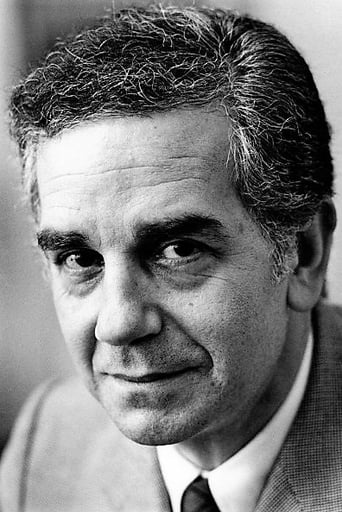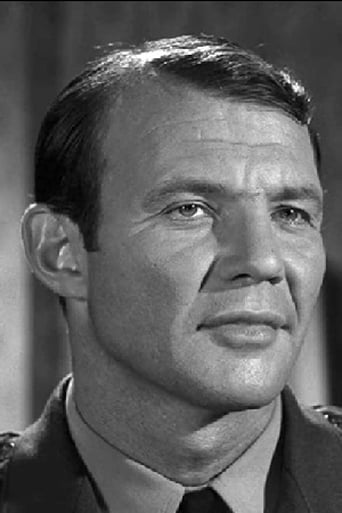MartinHafer
When this film first began, I was pretty pleased. I loved the dialog and the look of the crooks (with trench coats and fedora hats)--it was almost like a late 40s-50s example of film noir but in color. It's obvious that director Melville was trying to copy, to an extent, this retro look and style.If you are an American, the first thing you'll probably notice apart from some noir touches is that two of the gang members in this film are American actors whose lines are all dubbed into French. Richard Crenna and Michael Conrad (from "Hill Street Blues") have major parts in the film. This isn't super surprising as it was pretty common in Europe for studios to use American actors and dub their lines--especially in Italian films. My assumption is that the American actors' star power helped ticket sales, though in some of these cases the actors did NOT contribute well to the film. In some cases this is because the dubbing was done very poorly--fortunately, in this film it's pretty good.The film consists of showing the crime and investigation from two alternating views--the crooks and the cop (Alain Delon). The film bounces back and forth quite often but manages to do this effectively. The caper is a bank robbery in which one of the gang members is shot. However, it's clear they are professionals and they've taken a lot of steps to cover their tracks and effectively hide the loot. Interestingly, however, there turn out to be a few twists. First, the initial robbery was not THE big score in the film--this would come later. Second, while the scene made little sense (why sneak into a hospital to kill a guy you could have killed much easier before YOU dropped him off at the hospital in the first place?!), it was an wild twist to see how the handled the gang member who was shot. This scene with the beautiful Catherine Deneuve was quite shocking...and effective. Third, Delon's role turns out to intersect with the gang in a way you might not expect.Unfortunately, while the film is handled very well in most ways and shows how wonderfully you can make a film with such economy of language (there is VERY little dialog in the film), a major problem in the movie starts at the 53 minute point. The action switches to a train and you see one of the sloppiest uses of models I've seen since the last time I watched a Godzilla film! It looks just a kid's HO-gauge train set and a cheap helicopter model---which is exactly what they must be! Pretty sloppy. What also bothers me about this is that I noticed some score of 10 among the reviews. How can you give a film a 10 with such sloppy effects? I don't expect mega-million dollar effects, but this was just botched badly and looks bad...and a 10 would seem to imply perfection or at least near-perfection. Plus, plot-wise, don't you think someone on the train would have noticed a helicopter hovering just a few yards above the train for so long?! Fortunately, following these dumb scenes the film DID get better! Up until the silly scenes, I might have given this film a 9. However, considering how many scenes were done with crappy looking models, I think a fair overall score is 7 as it still held my interest. Pretty good and with a lot of potential to be a lot better--unfortunately, it's not among Melville's best though it turned out to be his last.
debblyst
All right, all right, so "Un Flic" is "flawed" and not on the same level as "Le Samouraï" -- but then how many films are? Yes, it's "flawed", obsessive, ambitious, made by an artist who was on top of the world after a succession of critical and box-office hits and probably felt like risking more -- and he did! It's also unique, mesmerizing, to be watched over and over again. And (as always with Melville) it's cinema in its purest, most uncompromising form."Un Flic" was Melville's last film, made one year before his sudden, fatal heart attack. It's ambitious all right: it stars France's top stars of the 1970s (Alain Delon and Catherine Deneuve, she in a supporting role at a time when she NEVER did supporting roles); and for the first time -- probably with an eye on the US market -- Melville uses an American star, Richard Crenna, who delivers his lines in absolutely fluent French (though post-dubbed for accent reasons)Talk about ambition and risk: Melville includes not one but TWO 20- minute-long, no-dialog, no-music heist scenes! The first one at the bank, by the rainy seashore, is a masterpiece of efficiency and atmosphere. Sadly, the second one with the helicopter/train is THE major flaw of the film, with its phony Thunderbird-like miniature models, especially difficult to accept in these our times of eye-popping CGI effects. It's also too long, it should have stayed out, though one can argue that it's probably the best-lit-miniature-model-heist-scene ever filmed!:)))The plot in "Un Flic" is a pretext to present the duel between the two complex male characters: Alain Delon's ideal cop made in Noir Heaven, and Richard Crenna's mastermind-thief-posing-as-charming-night-club-owner. They're on opposite sides, but Melville wants us to notice their similarities: their striking physical resemblance (they could be brothers), their camaraderie (Delon can only relax at Crenna's classy joint), their sharing the same woman (Deneuve). They're both cool, elegant, efficient gentlemen, who use violence only as a last resource (though the violence here is implicit, with hardly a drop of blood in view, unlike bloodbath fiends and pseudo Melville fans Scorsese, Tarantino and Woo). They're both art connoisseurs and sensitive to beauty: Crenna goes to the Louvre, admires Van Gogh's self-portrait and wears top fashion; Delon plays jazz on the piano proficiently, dresses impeccably (for a cop) and recognizes a Maillol sculpture when he sees one. But they can also be tough as hell: Crenna doesn't blink when he plans the death of his wounded sidekick at the hospital, and Delon coldly waits for a man to commit suicide instead of preventing it.Tough as they are, they're surprisingly open-minded when it comes to sex: Delon treats the robbed old homosexual and his teenage lover/thief with unflappable professionalism and even politeness, and is perfectly aware of the transvestite informer's crush on him (the transvestite's makeup and hair color resemble Deneuve's; insinuations galore). And in a revealing, silent scene at the bar, we can tell that the Deneuve-sharing is not an issue (yet). But in Melville's world, affinities, friendship and "modern" sexual morals collapse when the code of honor between males is broken. Delon is OK with gay people and ménages-à-troi but not with Crenna betraying his trust and fooling him professionally. The Melville code comes from Westerns and Samurai movies; the price of betrayal is death. When Delon realizes he's been double-crossed, there's no place for mercy or compromise in his heart; revenge is the only way out, AND he has the law on his side.A word about the acting: perhaps Delon doesn't seem very excited to play a cop -- who does? -- but his last 15 minutes are simply magnificent: just watch his face at the bar when he realizes Crenna is lying; it melts down with painful disillusion. And in the last scene over the closing credits, he drives his car drained of all life; he's broken inside, terribly lonely, an empty carcass. Crenna is subtle and properly sympathetic: cop-hater Melville clearly wants us to root for him. Apparently, Deneuve is there just to parade her amazing beauty, but check out the hospital "coup de grâce" scene: no angel of death was ever colder, blonder, more efficient or gorgeous. It makes us think once again what a shame she never worked for Hitchcock!The visual pleasures in "Un Flic" are so many that multiple viewings are required: the elegant decors, the fabulous cars (that silver Jaguar!), the chic wardrobe and the city of Paris at its most stunning. There's a telling scene at the Louvre where Melville seems to be comparing himself to the great impressionists: his camera lingers on a painting with a very similar palette as his own (icy blues, pale gris, cold grays). It's a "coup de vanité" from a man who -- like the greatest visual artists -- managed to create an instantly recognizable world of his own through his obsessive themes, unique visual expression and fabulous technique.The only way you can dislike "Un Flic" is if you're addicted to hyperactive, loud, chopped films; if you can appreciate moderato-paced subtlety and unique visual sophistication, you can do no wrong with this film. Melville's "flawed" work towers over thousands of brainless, spineless, bloody thrillers –- after all, "Un Flic" is signed by the one and only King of Cool. Enjoy, enjoy, enjoy.





